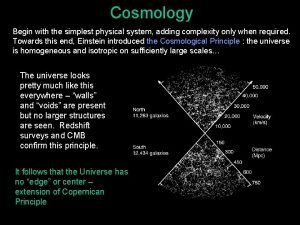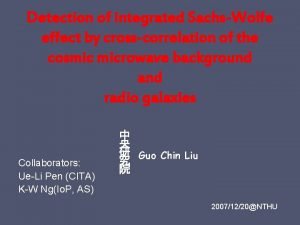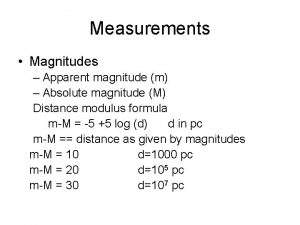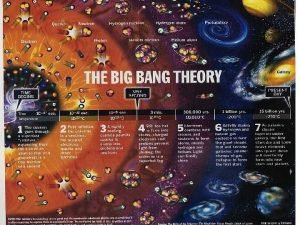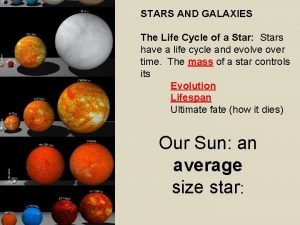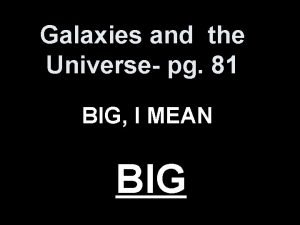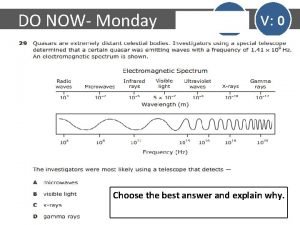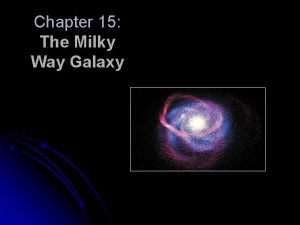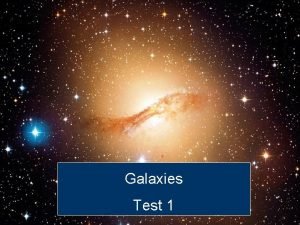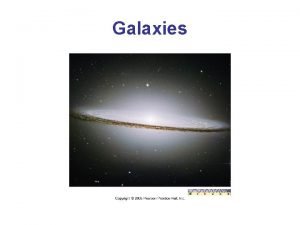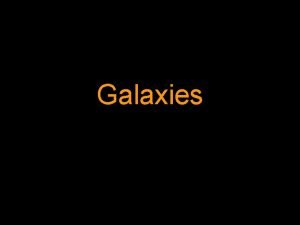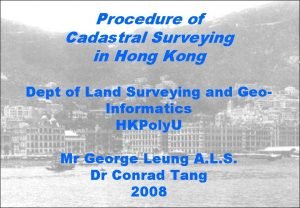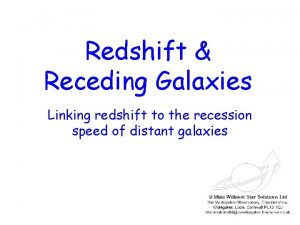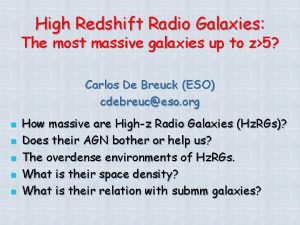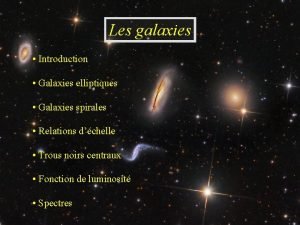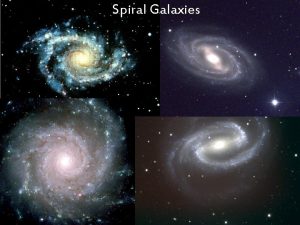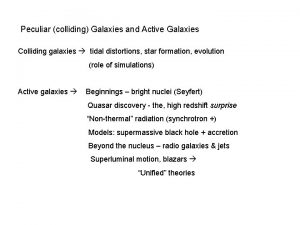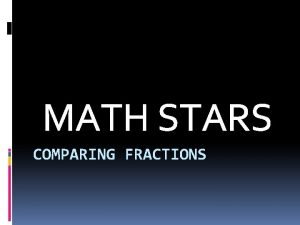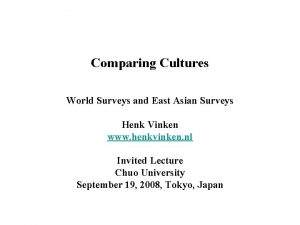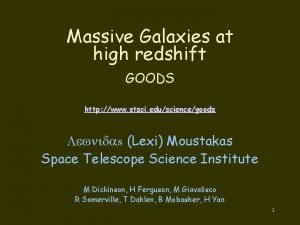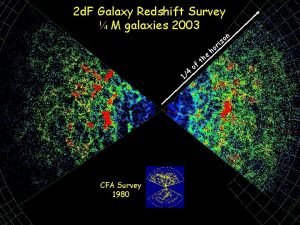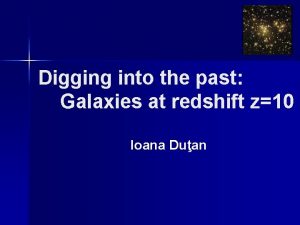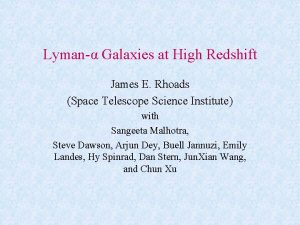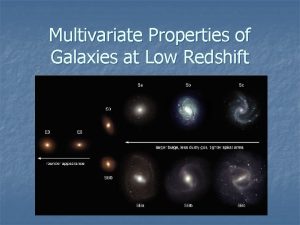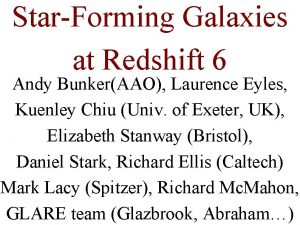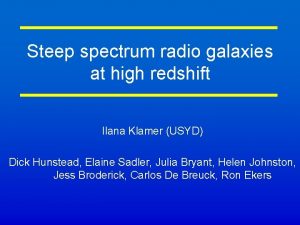Comparing with redshift surveys of galaxies Redshift surveys































- Slides: 31

Comparing with redshift surveys of galaxies

Redshift surveys –brief review • • CFA -----2000 galaxies (1983) Las Campanas ----25000 galaxies (1996) 2 d. F----250, 000 galaxies (2003) SDSS----900, 000 galaxies (2008? )

The role of different observations




Clustering and environment analysis • The key is to account for the incompleteness correctly • For example, two-point correlation function is measured very simply with DD(r)/RR(r)1, where DD and RR are the number of pairs of galaxies in the observed sample and in the random sample respectively; • The key is to construct the random sample correctly

Incompleteness or selection effects • Magnitude limited sample----radial selection effect; • Limiting magnitude variation (0. 1 typically) across the survey region; • Survey boundary; • Redshift measurement completeness; – Sampling rate; – Magnitude dependent redshift incompleteness – Fiber collision




Random sample • A sample of the points randomly distributed spatially but with the same observational selection effects




Redshift two-point correlation functions for DR 2 (Li, C. et al. astroph/0509874; 0509873; see also Zehavi et al. 2005) 函红 数移 空 间 的 星 系 两 点 相 关


• Luminosity dependence of the bias (r_p=2. 7 Mpc/h; Zehavi et al. 2005) • Stellar mass dependence (Li, et al 2005 a, b) • 星系成团的幅度,即 偏袒因子b,随光度 (上图)和恒星质量 (下图)的变化。



Bimodal distribution in the colormagnitude diagram (SDSS)

Three ways of interpreting • Halo Occupation Distribution (HOD) model (e. g. Jing et al. 1998; Yang et al 2003) • Using galaxy formation models – Hydro/N-body simulations with star formation (physical processes; id of galaxies? e. g. V. Springel et al. 2005) – Semi-analytical models of galaxy formation + N-body simulations (e. g. Kauffmann et al. 1999)


• • Physical processes of galaxy formation Formation of dark halos; gas shock heated; Gas cooled radiatively; Stars formed from cold gas; Massive stars short lived; form neutron stars and supernova explosions • Explosions inject energy and metals into interstellar medium (hot+cold); heating and enrich---feedback effects • Mergers of galaxies after their host halos merge; • Black hole formation and its AGN feedback



Dark matter Galaxies: red for E; blue for spirals

理论比较 构建SDSS的模拟样本 SDSS DR 4 L 500 L 100+L 300

Agreement after the reduction of faint satellites

Subhalo resolved: the bimodal color-mag distribution is much better reproduced

Summary • Main features of galaxies can be explained in current galaxy formation models; • High precision modeling for galaxy formation is still challenging, for very complicated physical process
 Redshift shared nothing
Redshift shared nothing Aws queue icon
Aws queue icon The universe expanding than
The universe expanding than Redshift create index
Redshift create index Redshift deadlock detected
Redshift deadlock detected E 0
E 0 Big bang solar system
Big bang solar system Elliptical galaxy
Elliptical galaxy Life cycle of galaxies
Life cycle of galaxies Universe pg
Universe pg Milky way galaxy shape
Milky way galaxy shape Brainpop galaxies quiz answers
Brainpop galaxies quiz answers Tipus de galaxies
Tipus de galaxies Elliptical galaxies facts
Elliptical galaxies facts Galaxies lesson plan
Galaxies lesson plan Chapter 30 galaxies and the universe
Chapter 30 galaxies and the universe 4 types of galaxies
4 types of galaxies Properties of elliptical galaxies
Properties of elliptical galaxies Classification
Classification What are galaxies
What are galaxies How are active galaxies classified?
How are active galaxies classified? Electromagnetic star
Electromagnetic star Evolution of galaxies
Evolution of galaxies The pity relation for an adiabatic expansion is
The pity relation for an adiabatic expansion is Snap surveys
Snap surveys Theworxhub qa & surveys
Theworxhub qa & surveys Types of land surveys
Types of land surveys Types of security survey
Types of security survey Highway surveys
Highway surveys The enacted curriculum
The enacted curriculum Cadastral surveys
Cadastral surveys Syndicate sources
Syndicate sources


